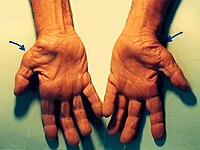
Photo from wikipedia
Carpal tunnel syndrome (CTS) is the most common peripheral entrapment neuropathy. Its diagnosis is based on clinical symptoms and neurophysiological evaluation. Recently, ultrasonography has been introduced as a promising noninvasive… Click to show full abstract
Carpal tunnel syndrome (CTS) is the most common peripheral entrapment neuropathy. Its diagnosis is based on clinical symptoms and neurophysiological evaluation. Recently, ultrasonography has been introduced as a promising noninvasive diagnostic alternative. In this study, the authors compared ultrasonography with neurophysiological findings for the diagnosis of CTS in 96 patients/hands with clinical symptoms of CTS. The latency, amplitude, distance, and velocity of the median and ulnar nerves were measured. Needle electromyography was performed in the abductor pollicis brevis, in addition to muscles of the arm and forearm, to exclude proximal median nerve, brachial plexus, or radicular abnormalities. Ultrasonography was based on the morphologic/anatomic changes of the median nerve cross-sectional area in the sagittal plane of the wrist at the level of the pisiform bone, the changes of its regional echogenicity, and the identification of coexisting pathologies, such as tenosynovitis, space-occupying lesions, supplementary muscles, and vessels, that may provoke indirectly an increase of the pressure in the carpal tunnel. Eighty-seven (90%) of the 96 patients/hands with clinical symptoms of CTS showed positive findings in both ultrasonography and nerve conduction studies. Six (6%) patients showed positive findings only in nerve conduction studies, and 3 (3%) patients showed positive findings only in ultrasonography; the difference was not statistically significant. The sensitivity and the specificity of nerve conduction studies compared with ultrasonography was 97% and 89% compared with 94% and 55%, respectively. A positive correlation and proportional increase of the ultrasonography measurements compared with the increase of the nerve conduction studies severity was observed. [Orthopedics. 201x; xx(x):xx-xx.].
Journal Title: Orthopedics
Year Published: 2019
Link to full text (if available)
Share on Social Media: Sign Up to like & get
recommendations!